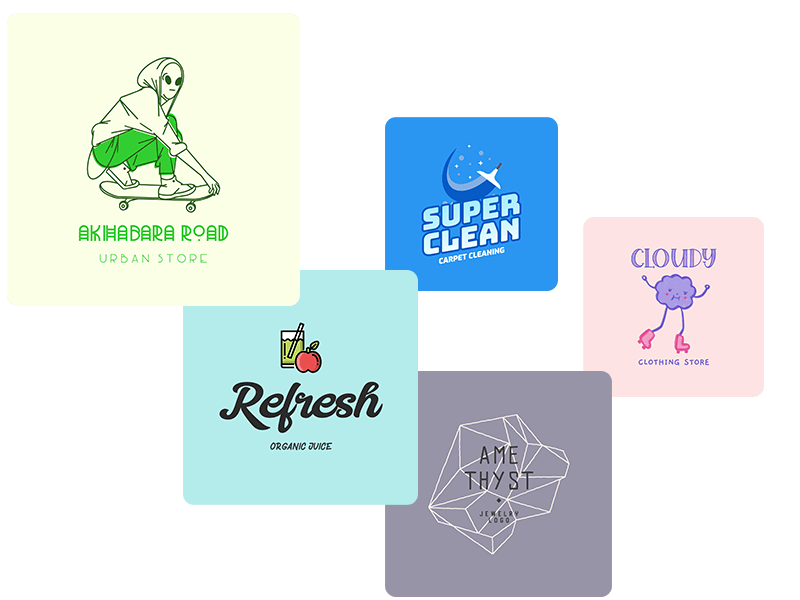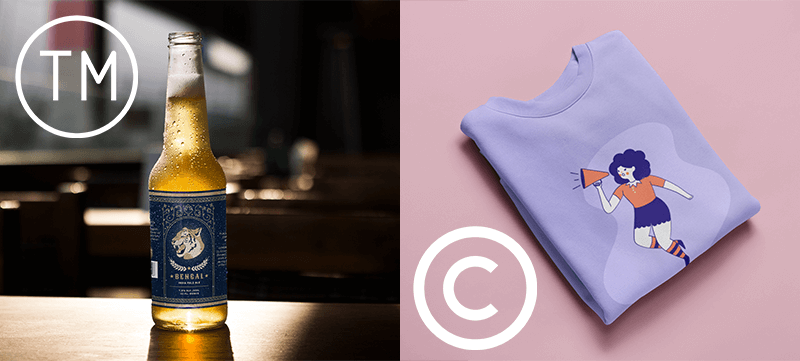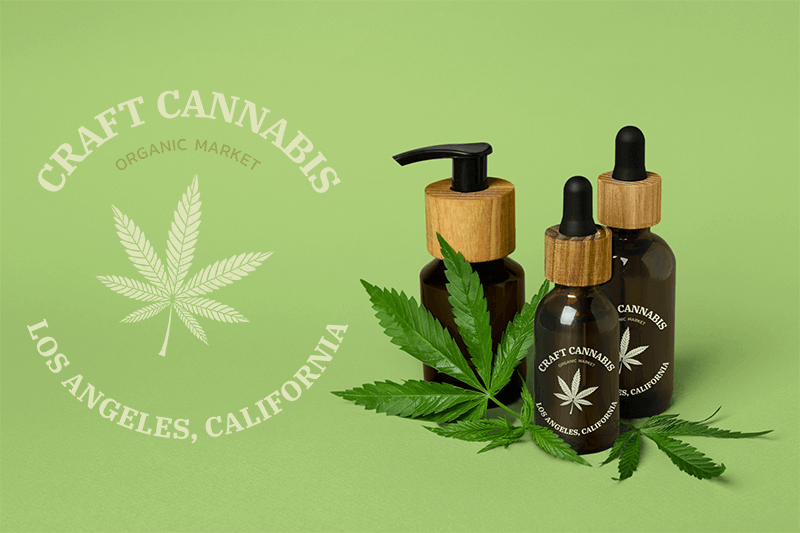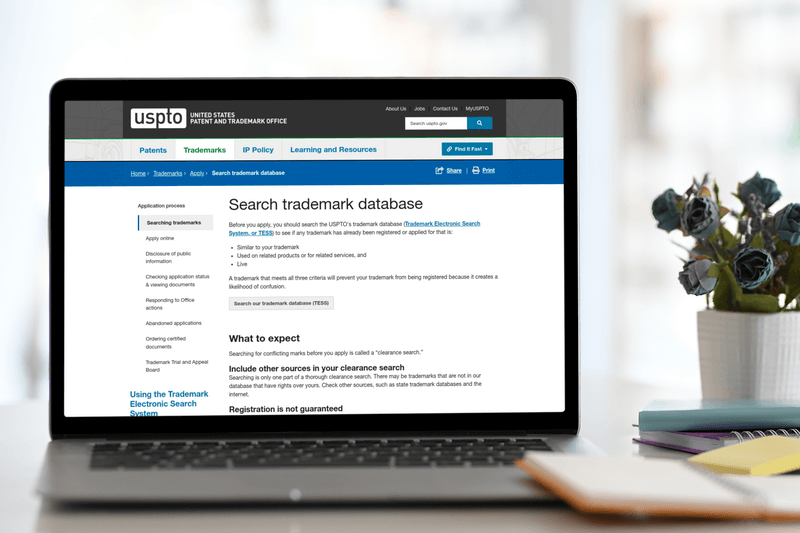
Making a logo for your business takes time, creativity, and money if you hire someone to make it for you. Because of all this, it’s important to know how to trademark a logo to keep it protected under the law.
Before you decide what the right next steps for your business are, use this guide to learn how you can benefit from trademarking your logo and how to do it.
In this guide, we’ll answer these questions for you:
- What Does Trademark Mean?
- What Is the Difference Between Copyright and Trademark?
- Do I Need to Trademark My Logo?
- How Much Does It Cost to Trademark a Logo?
- What Types of Trademark Exist?
- How to Trademark a Logo with the USPTO
- Final Thoughts
What Does Trademark Mean?
You’ve probably heard the term trademark plenty of times, but what does it actually mean? A trademark is an intellectual property made up of a word, phrase (a string of words), symbol, design, or a combination of any of these elements. It is also linked to products or services coming from a source, such as a person or business, and helps to distinguish them from the products or services of another. This is usually a logo or business name that often appears on the products themselves or on the packaging.
A trademark is unique and individual so as to help consumers distinguish between different products. Think of Pepsi and Coca-Cola; both sell similar products, but their trademark is different and helps consumers differentiate their products, influencing their final purchasing decision.
Trademarking your logo ensures other businesses can’t use your logo, claim it as their own, or use a similar logo that can confuse your audience.
Your logo has to be a unique enough word, phrase, symbol, design, or combination of these elements to even be legally considered for trademark. Once your unique logo is trademarked, this will stop others from copying your work by granting it protection under trademark law. Your logo will be legally protected against unauthorized use, such as counterfeiting, copying, and fraud. You can even pursue damages and compensation if your logo is used fraudulently.
While a trademark isn’t a requirement for running your business, that doesn’t always mean you should skip it. It can have plenty of benefits, so it’s worth looking into how it might help your brand.
👉 Pro tip: You can work with a designer to design your brand logo, but be sure they give you ownership of the logo.

What Is the Difference Between Copyright and Trademark?
Many people use the trademark and copyright of the word interchangeably, but they actually are quite different. Both offer legal protection, but what they protect sets them apart.
What Can I Copyright?
To copyright something, it has to be tangible. In other words, it has to be something you can hold, see, or hear. Examples of things you can copyright include books, movies, artwork, and choreography, among other things. Think of copyright as something that protects creative work.
For example, if you sell t-shirts online, you can copyright your t-shirt designs so that other sellers can’t copy them and pass them off as their own. At the same time, you mustn’t copy someone else’s designs because they can take legal action against you.
What Can I Trademark?
As stated earlier, a trademark is made up of a recognizable word, phrase, design, symbol, or a combination of these that identifies your brand and business offering (products or services).
Trademarking your logo will protect it from being used by competitors. For example, if a company sells products similar to yours and uses your logo, you can take legal action.
Similarly, if a competitor starts using a logo that is suspiciously similar to yours to trick people into buying their products, you can also take legal action. Use a trademark to protect things like your company’s name, slogan, or logo.
👉 Pro tip: Learn how to run a trademark search to protect your business and wallet.

Do I Need to Trademark My Logo?
It’s not always necessary to trademark a logo to operate a successful business, but it is a good idea. You never know how big your business may grow and what markets you may end up selling in. Below are some benefits to consider when deciding whether or not to trademark your logo:
Benefits of Trademarking a Logo
- Proof of ownership. Technically, once you start using your logo commercially, you have some legal protection against others copying or stealing it. However, this can be harder if you haven’t registered your logo. Once your logo is trademarked, you’ll have legal proof that you own the trademark.
- Peace of mind. Once your trademark application is approved, you can be sure your logo isn’t similar enough to another trademark to cause confusion. If you haven’t done a trademark search, you may be infringing on someone’s trademark without even knowing it. If they decide to sue you for this, you can lose rights to your logo and business name, causing you to lose customers.
- Protect your own trademark. Similarly, once you trademark your logo, you have legal ownership of it. If you find that another business uses your trademarked logo or something very similar, you can sue them. Pursuing legal action when this is violated will be much easier since you have your paperwork in order.
- Expand internationally. After getting your trademark federally approved in the United States, you can use it to register in foreign countries.
- Professional look. Once your trademark has been approved, you can legally add the ® symbol to it. This will let others know that you have done the work to trademark your logo, stopping them from trying to use your trademark illegally.

How Much Does It Cost to Trademark a Logo
There isn’t one easy answer for this because several factors can affect the final price. The level of protection you want, such as a state trademark versus a federal trademark, and the state you live in can both play a role in the final price.
Rather than settling for the cheapest option, think about what you plan to do with your business in the future. If you have plans to sell at a national level, then a federal trademark makes the most sense. The same is true if you plan on expanding your business overseas since you will need a federal trademark to apply for a foreign trademark.
👉 Pro tip: If you plan to file for a state-level trademark, check out this information by state.
If you decide that a federal trademark is what you need, you’ll need to file through the United States Patent and Trademark Office. There are two filing options:
- TEAS Plus: $250 per class of goods/services
- TEAS Standard: $350 per class of goods/services
Consider hiring an attorney specializing in trademark law to help you with the application. An attorney will charge you, but they will also ensure you don’t make mistakes on your application.
What Types of Trademarks Exist?
Since the process can be pricey and take some time, you want to ensure you’re getting the right type of trademark for your logo. Below are some of the trademark options you can choose from:
Common Law Trademark
This is the most basic level of protection you will get. You don’t need to register your logo since this protection applies as soon as you start using your logo commercially.
The protection level you get is minimal because the geographic area you’re covered in is limited. It can be harder to prove that you’ve been using your trademark for as long as you have since you won’t have legal documents to prove it.
You can use the ™ symbol with your logo to scare off copycats, but ultimately you’re responsible for taking action to protect your common law trademark. You can send a cease-and-desist letter to a business that starts using your logo, but the legal process can become a headache.
State Level Trademark
As its name suggests, this type of trademark will protect your intellectual property at the state level. If you are only selling goods and services in a single state, then this level of protection may be just fine for you.
What this type of trademark offers in terms of protection will vary by state. The price to file at the state level is much more affordable than a federal trademark, and your logo will still be listed as trademarked.
Keep in mind that federal trademarks take priority over state-level ones.
Federal Trademark
A federal trademark will give your logo the highest level of protection, and its price reflects that. If you plan to expand your business internationally, this makes filing for an international trademark much easier.
Your trademark will be protected from infringement and fraud at a national level and will also protect you at a state level.
Most online businesses will likely need this type of trademark protection since they tend to sell across state lines. You also have to offer your products in at least two different states to qualify for this type of trademark.
Your federal trademark will protect you for 10 years, and you can refile after that to continue being the owner of your logo.
How to Trademark a Logo with the USPTO
1. Ensure your trademark doesn’t contain the following items:
- A living person’s name that you don’t have consent to use
- The United States flag
- Government insignia
- The image or name of a U.S. president who is no longer living unless you have gotten consent through the proper channels
- Disrespectful words or symbols related to beliefs, national symbols, institutions, and people
- The USPTO can also deny your trademark if they find it deceptive, immoral, or scandalous.
2. Run a trademark search.
Search through the USPTO trademark database to identify other trademarks that are the same or similar to yours. Don’t skip this step because your application will be denied if your trademark is already being used.
The USPTO database isn’t the only one that exists, so be sure to look through as many as possible to avoid having your application denied. A trademark attorney can be a great asset in this process since they have more experience and resources.
👉 Pro tip: One of the most common reasons a trademark application gets rejected is because the trademark or one very similar to it is already registered.

3. Identify the correct product category.
Part of your trademark application will require you to describe the goods or services your logo will represent. There are 45 different classes to choose from, so it can get tricky. If you choose the wrong one, your application will be denied. You can fix this error, but you will have to pay additional fees to update your application.
4. Gather the relevant information.
To make filling out your application easier and less time-consuming, make sure you have the information you need before you start. Remember that your application can be denied even for small errors, so don’t let anything slip.
Things to have on hand include:
- The name and address of the person or entity filing for the trademark
- The date when you first used the logo you are trademarking
- Proof that your logo is being used in at least two states
- The products or goods being sold that are associated with the trademark
- The class your trademark falls under
- A specimen or example of your logo being used commercially, such as a photo (JPG) of your logo on the products you sell
- An image (JPG) of your logo

5. File your application.
The easiest way to file is online through the USPTO website, but it can take a while to review and process your application after it’s been submitted.
Once you have submitted your application, it can take six to nine months to hear back. You can use the serial number given to you upon filing to check the status of your application.
6. Fix any errors.
You will be notified if there are errors in your application that need to be fixed. You have six months to correct these errors and resubmit your application. If you wait longer than six months to fix the mistakes, your application will be deemed abandoned.
Final Thoughts
Trademarking your brand’s logo is a must for the integrity and protection of your business. If you haven’t trademarked your logo yet, it’s never too late to get started. Or, if you’re only just starting to create your logo, check out this useful guide on the differences between a logo and an icon.
Once your logo is trademarked, you can print your logo on everything! Learn how to get everything from custom t-shirts to packaging featuring your logo design.
If you haven’t trademarked your logo yet, let us know what’s stopping you in the comments below. ⤵️

2 Comments
anthony
hi i had bought placeit image from you guys and me and my girl want to have it copywritten so that nobody else dont use it or copy it from our custom clothing business do you guys copy right if customers paid out in full to see our logo you guys created our business is called T&D Customs
Valeria Santalla
Hi Anthony! Thank you for reaching out!
Our customer can copyright the logo variation (color, text, etc…), but that won’t stop our users from creating new variations of the template; I would recommend using the logo as a base and modifying it further to make it unique. 🙂